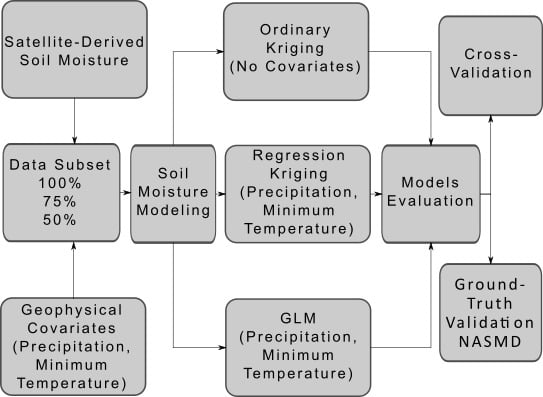Spatial Gap-Filling of ESA CCI Satellite-Derived Soil Moisture Based on Geostatistical Techniques and Multiple Regression
Abstract
:1. Introduction
2. Materials and Methods
2.1. Region of Interest
2.2. Data
2.2.1. Satellite-Derived Soil Moisture
2.2.2. Soil Moisture Covariates
2.2.3. Validation Data
2.3. Gap-Filling Methods
2.3.1. Ordinary Kriging
2.3.2. Regression Kriging
2.3.3. Generalized Linear Models
2.4. Ground-Truth Validation
2.4.1. Reference Correlation between NASMD and Satellite-Derived Soil Moisture
2.4.2. Correlation between Predicted Soil Moisture and NASMD
3. Results
3.1. OK and RK Models Selected for Soil Moisture Predictions
3.2. Cross-Validation of Predicted Values
3.3. Ground-Truth Validation with NASMD
3.4. Spatial Gap-Filling Performance of Modeling Methods
4. Discussion
5. Conclusions
Supplementary Materials
Author Contributions
Funding
Acknowledgments
Conflicts of Interest
References
- Ward, S. The Earth Observation Handbook; ESA Communication Production Office: Noordwijk, The Netherlands, 2008; ISBN 978-92-9221-408-1. [Google Scholar]
- Koster, R.D.; Suarez, M.J. Soil Moisture Memory in Climate Models. J. Hydrometeorol. 2001, 2, 558–570. [Google Scholar] [CrossRef]
- Seneviratne, S.I.; Corti, T.; Davin, E.L.; Hirschi, M.; Jaeger, E.B.; Lehner, I.; Orlowsky, B.; Teuling, A.J. Investigating soil moisture-climate interactions in a changing climate: A review. Earth Sci. Rev. 2010, 99, 125–161. [Google Scholar] [CrossRef]
- Meehl, G.A.; Washington, W.M. A Comparison of Soil-Moisture Sensitivity in Two Global Climate Models. J. Atmos. Sci. 1988, 45, 1476–1492. [Google Scholar] [CrossRef] [Green Version]
- Engman, E.T. Applications of microwave remote sensing of soil moisture for water resources and agriculture. Remote Sens. Environ. 1991, 35, 213–226. [Google Scholar] [CrossRef]
- Narasimhan, B.; Srinivasan, R. Development and evaluation of Soil Moisture Deficit Index (SMDI) and Evapotranspiration Deficit Index (ETDI) for agricultural drought monitoring. Agric. For. Meteorol. 2005, 133, 69–88. [Google Scholar] [CrossRef]
- Davidson, E.A.; Belk, E.; Boone, R.D. Soil water content and temperature as independent or confounded factors controlling soil respiration in a temperate mixed hardwood forest. Glob. Chang. Biol. 1998, 4, 217–227. [Google Scholar] [CrossRef] [Green Version]
- Williams, C.A.; Albertson, J.D. Soil moisture controls on canopy-scale water and carbon fluxes in an African savanna. Water Resour. Res. 2004, 40, 1–14. [Google Scholar] [CrossRef] [Green Version]
- Dorigo, W.A.; Wagner, W.; Hohensinn, R.; Hahn, S.; Paulik, C.; Xaver, A.; Gruber, A.; Drusch, M.; Mecklenburg, S.; Van Oevelen, P.; et al. The International Soil Moisture Network: A data hosting facility for global in situ soil moisture measurements. Hydrol. Earth Syst. Sci. 2011, 15, 1675–1698. [Google Scholar] [CrossRef] [Green Version]
- Dorigo, W.A.; Xaver, A.; Vreugdenhil, M.; Gruber, A.; Hegyiová, A.; Sanchis-Dufau, A.D.; Zamojski, D.; Cordes, C.; Wagner, W.; Drusch, M. Global Automated Quality Control of In Situ Soil Moisture Data from the International Soil Moisture Network. Vadose Zone J. 2013, 12. [Google Scholar] [CrossRef]
- Dorigo, W.A.; Gruber, A.; De Jeu, R.A.M.; Wagner, W.; Stacke, T.; Loew, A.; Albergel, C.; Brocca, L.; Chung, D.; Parinussa, R.M.; et al. Evaluation of the ESA CCI soil moisture product using ground-based observations. Remote Sens. Environ. 2015, 162, 380–395. [Google Scholar] [CrossRef]
- Robock, A.; Mu, M.; Vinnikov, K.; Trofimova, I.V.; Adamenko, T.I. Forty-five years of observed soil moisture in the Ukraine: No summer desiccation (yet). Geophys. Res. Lett. 2005, 32, 1–5. [Google Scholar] [CrossRef] [Green Version]
- Martínez-Fernández, J.; Ceballos, A. Temporal Stability of Soil Moisture in a Large-Field Experiment in Spain. Soil Sci. Soc. Am. J. 2003, 67, 1647. [Google Scholar] [CrossRef]
- Schaefer, G.L.; Cosh, M.H.; Jackson, T.J. The USDA Natural Resources Conservation Service Soil Climate Analysis Network (SCAN). J. Atmos. Ocean. Technol. 2007, 24, 2073–2077. [Google Scholar] [CrossRef]
- Quiring, S.M.; Ford, T.W.; Wang, J.K.; Khong, A.; Harris, E.; Lindgren, T.; Goldberg, D.W.; Li, Z. The North American Soil Moisture Database: Development and Applications. Bull. Am. Meteorol. Soc. 2016, 97, 1441–1459. [Google Scholar] [CrossRef]
- Entekhabi, D.; Njoku, E.G.; O’Neill, P.E.; Kellogg, K.H.; Crow, W.T.; Edelstein, W.N.; Entin, J.K.; Goodman, S.D.; Jackson, T.J.; Johnson, J.; et al. The soil moisture active passive (SMAP) mission. Proc. IEEE 2010, 98, 704–716. [Google Scholar] [CrossRef]
- ESA. SMOS Mission Summary. Available online: https://earth.esa.int/web/guest/missions/esa-eo-missions/smos/mission-summary (accessed on 13 July 2018).
- Dorigo, W.; Wagner, W.; Albergel, C.; Albrecht, F.; Balsamo, G.; Brocca, L.; Chung, D.; Ertl, M.; Forkel, M.; Gruber, A.; et al. ESA CCI Soil Moisture for improved Earth system understanding: State-of-the art and future directions. Remote Sens. Environ. 2017, 203, 185–215. [Google Scholar] [CrossRef]
- Topp, G.C.; Davis, J.L.; Annan, A.P. Electromagnetic Determination of Soil Water Content: Measruements in Coaxial Transmission Lines. Water Resour. Res. 1980, 16, 574–582. [Google Scholar] [CrossRef] [Green Version]
- Chung, D.; Dorigo, W.; De Jeu, R.; Kidd, R.; Wagner, W. ESA Climate Change Initiative Phase II – Soil Moisture, Product Specification Document (PSD); D.1.2.1 Version 4.4; Earth Observation Data Centre for Water Resources Monitoring (EODC) GmbH: Vienna, Austria, 2018; p. 49. [Google Scholar]
- Gruber, A.; Dorigo, W.A.; Crow, W.; Wagner, W. Triple Collocation-Based Merging of Satellite Soil Moisture Retrievals. IEEE Trans. Geosci. Remote Sens. 2017, 55, 6780–6792. [Google Scholar] [CrossRef]
- Gruber, A.; Scanlon, T.; van der Schalie, R.; Wagner, W.; Dorigo, W. Evolution of the ESA CCI Soil Moisture Climate Data Records and their underlying merging methodology. Earth Syst. Sci. Data Discuss. 2019, 1–37. [Google Scholar] [CrossRef] [Green Version]
- Wang, G.; Garcia, D.; Liu, Y.; de Jeu, R.; Johannes Dolman, A. A three-dimensional gap filling method for large geophysical datasets: Application to global satellite soil moisture observations. Environ. Model. Softw. 2012, 30, 139–142. [Google Scholar] [CrossRef]
- Kondrashov, D.; Ghil, M.; Kondrashov, D.; Spatio-temporal, M.G. Spatio-temporal filling of missing points in geophysical data sets To cite this version: HAL Id: Hal-00331089 Nonlinear Processes in Geophysics Spatio-temporal filling of missing points in geophysical data sets. Nonlinear Process. Geophys. 2006, 13, 151–159. [Google Scholar] [CrossRef] [Green Version]
- Mao, H.; Kathuria, D.; Duffield, N.; Mohanty, B.P. Gap Filling of High-Resolution Soil Moisture for SMAP/Sentinel-1: A Two-Layer Machine Learning-Based Framework. Water Resour. Res. 2019, 55, 6986–7009. [Google Scholar] [CrossRef] [Green Version]
- DeLiberty, T.L.; Legates, D.R. Spatial Variability and Persistence of Soil Moisture in Oklahoma. Phys. Geogr. 2008, 29, 121–139. [Google Scholar] [CrossRef]
- Hengl, T.; Heuvelink, G.B.M.; Stein, A. A generic framework for spatial prediction of soil variables based on regression-kriging. Geoderma 2004, 120, 75–93. [Google Scholar] [CrossRef] [Green Version]
- Cressie, N. The origins of kriging. Math. Geol. 1990, 22, 239–252. [Google Scholar] [CrossRef]
- Oliver, M.A.; Webster, R. (Richard) Basics Steps in Geostatistics: The Variogram and Kriging; SpringerBriefs in Agriculture; Springer: New York, NY, USA, 2015; ISBN 9783319158648. [Google Scholar]
- Kang, J.; Jin, R.; Li, X. Regression kriging-based upscaling of soil moisture measurements from a wireless sensor network and multiresource remote sensing information over heterogeneous cropland. IEEE Geosci. Remote Sens. Lett. 2015, 12, 92–96. [Google Scholar] [CrossRef]
- Hengl, T.; Heuvelink, G.B.M.; Rossiter, D.G. About regression-kriging: From equations to case studies. Comput. Geosci. 2007, 33, 1301–1315. [Google Scholar] [CrossRef]
- Brock, F.V.; Crawford, K.C.; Elliott, R.L.; Cuperus, G.W.; Stadler, S.J.; Johnson, H.L.; Eilts, M.D. The Oklahoma Mesonet: A Technical Overview. J. Atmos. Ocean. Technol. 1995, 12, 5–19. [Google Scholar] [CrossRef]
- Commission for Environmental Cooperation. 2010 Land Cover of North America at 30 Meters, Ed. 1. 2017. Available online: http://www.cec.org/tools-and-resources/north-american-environmental-atlas/land-cover-and-land-cover-change (accessed on 17 July 2019).
- Llamas, R.M.; Bonifaz, R.; Valdés, M.; Riveros-Rosas, D.; Leyva-Contreras, A. Spatial and temporal variations of atmospheric aerosol optical thickness in northwestern Mexico. Geofis. Int. 2013, 52, 321–341. [Google Scholar] [CrossRef] [Green Version]
- Thornton, M.M.; Thornton, P.E.; Wei, Y.; Mayer, B.W.; Cook, R.B.; Vose, R.S. Daymet: Monthly Climate Summaries on A 1-Km Grid for North America; Version 3; ORNL DAAC: Oak Ridge, TN, USA, 2018. [Google Scholar] [CrossRef]
- Parker, J.A.; Kenyon, R.V.; Troxel, D.E. Comparison of Interpolating Methods for Image Resampling. IEEE Trans. Med. Imaging 1983, MI–2. [Google Scholar] [CrossRef]
- Soil Survey Staff. Gridded Soil Survey Geographic (gSSURGO) Database for the Conterminous United States. United States Department of Agriculture, Natural Resources Conservation Service, 2016. Available online: https://gdg.sc.egov.usda.gov/ (accessed on 10 August 2019).
- Bertermann, D.; Bialas, C.; Morper-Busch, L.; Klug, H.; Rohn, J.; Stollhofen, H.; Psyk, M.; Jaudin, F.; Maragna, C.; Einarsson, G.M.; et al. ThermoMap—An Open-Source Web Mapping Application for Illustrating the very Shallow Geothermal Potential in Europe and selected Case Study Areas. Eur. Geotherm. Congr. 2013, 2013, 1–8. [Google Scholar]
- Conrad, O.; Bechtel, B.; Bock, M.; Dietrich, H.; Fischer, E.; Gerlitz, L.; Wehberg, J.; Wichmann, V.; Böhner, J. System for Automated Geoscientific Analyses (SAGA); v.2.1.4. Geosci. Model. Dev. 2015, 8, 1991–2007. [Google Scholar] [CrossRef] [Green Version]
- ESA. CCI ESA Soil Moisture CCI, Validation. Available online: https://www.esa-soilmoisture-cci.org/validation (accessed on 1 July 2019).
- Kutner, M.H.; Nachtsheim, C.J.; Neter, J.; Li, W. Applied Linear Statistical Models, 5th ed.; McGraw-Hill: New York, NY, USA, 2005. [Google Scholar]
- Jung, C.; Lee, Y.; Cho, Y.; Kim, S. A study of spatial soil moisture estimation using a multiple linear regression model and MODIS land surface temperature data corrected by conditional merging. Remote Sens. 2017, 9, 870. [Google Scholar] [CrossRef] [Green Version]
- Cai, Y.; Zheng, W.; Zhang, X.; Zhangzhong, L.; Xue, X. Research on soil moisture prediction model based on deep learning. PLoS ONE 2019, 14, e0214508. [Google Scholar] [CrossRef] [PubMed]
- Hiemstra, P. Automatic Interpolation Package. Available online: https://cran.r-project.org/web/packages/automap/index.html (accessed on 28 January 2020).
- Isaaks, E.H.; Srivastava, R.M. Ordinary Kriging. In Applied Geostatistics; Oxford University Press: New York, NY, USA, 1989; pp. 278–322. [Google Scholar]
- Cambardella, C.A.; Moorman, T.B.; Parkin, T.B.; Karlen, D.L.; Novak, J.M.; Turco, R.F.; Konopka, A.E. Field-Scale Variability of Soil Properties in Central Iowa Soils. Soil Sci. Soc. Am. J. 1994, 58, 1501. [Google Scholar] [CrossRef]
- Hengl, T.; Kempen, B.; Heuvelink, G.; Malone, B. Available online: https://rdrr.io/rforge/GSIF/ (accessed on 28 January 2020).
- Giraldo-Henao, R. Introducción a la Geoestadística, Teoría y Aplicación. Available online: https://geoinnova.org/blog-territorio/wp-content/uploads/2015/05/LIBRO_-DE-_GEOESTADISTICA-R-Giraldo.pdf (accessed on 28 January 2020).
- Kuhn, M. Caret: Classification and Regression Training. Available online: http://topepo.github.io/caret/index.html (accessed on 28 January 2020).
- Stein, M.L. Interpolation of Spatial Data, Some Theory for Kriging; Springer: Chicago, IL, USA, 1999. [Google Scholar]
- Taylor, K.E. Summarizing multiple aspects of model performance in a single diagram. J. Geophys. Res. 2001, 106, 7183–7192. [Google Scholar] [CrossRef]
- Lemon, J. Plotrix: A package in the red light district of R. R News 2006, 6, 8–12. [Google Scholar]
- Tang, C.; Chen, D. Interaction between Soil Moisture and Air Temperature in the Mississippi River Basin. J. Water Resour. Prot. 2018, 9, 9–12. [Google Scholar] [CrossRef] [Green Version]
- Salathé, E.P., Jr.; Steed, R.; Mass, C.F.; Zahn, P.H. A High-Resolution Climate Model for the U.S. Pacific Northwest: Mesoscale Feedbacks and Local Responses to Climate Change. J. Clim. 2008, 21, 5708–5726. [Google Scholar] [CrossRef] [Green Version]
- Ding, Y.; Wang, Y.; Miao, Q. Research on the spatial interpolation methods of soil moisture based on GIS. Proceedings of 2011 International Conference on Information Science and Technology, Nanjing, China, 26–28 March 2011; pp. 709–711. [Google Scholar]
- Chen, H.; Fan, L.; Wu, W.; Liu, H. Bin Comparison of spatial interpolation methods for soil moisture and its application for monitoring drought. Environ. Monit. Assess. 2017, 189. [Google Scholar] [CrossRef]
- Zhang, M.; Li, M.; Wang, W.; Liu, C.; Gao, H. Temporal and spatial variability of soil moisture based on WSN. Math. Comput. Model. 2013, 58, 820–827. [Google Scholar] [CrossRef]
- Cruz-Cárdenas, G.; López-Mata, L.; Ortiz-Solorio, C.A.; Villaseñor, J.L.; Ortiz, E.; Silva, J.T.; Estrada-Godoy, F. Interpolation of mexican soil properties at a scale of 1:1,000,000. Geoderma 2014, 213, 29–35. [Google Scholar] [CrossRef]
- De Benedetto, D.; Castrignanò, A.; Quarto, R. A Geostatistical Approach to Estimate Soil Moisture as a Function of Geophysical Data and Soil Attributes. Procedia Environ. Sci. 2013, 19, 436–445. [Google Scholar] [CrossRef] [Green Version]
- Abuduwaili, J.; Tang, Y.; Abulimiti, M.; Liu, D.; Ma, L. Spatial distribution of soil moisture, salinity and organic matter in Manas River watershed, Xinjiang, China. J. Arid Land 2012, 4, 441–449. [Google Scholar] [CrossRef]
- Brusilovskiy, E. Spatial Interpolation: A Brief Introduction. Available online: http://www.bisolutions.us/A-Brief-Introduction-to-Spatial-Interpolation.php (accessed on 22 October 2019).
- Odeh, I.O.A.; McBratney, A.B.; Chittleborough, D.J. Further results on prediction of soil properties from terrain attributes: Heterotopic cokriging and regression-kriging. Geoderma 1995, 67, 215–226. [Google Scholar] [CrossRef]
- Zhu, Q.; Lin, H.S. Comparing Ordinary Kriging and Regression Kriging for Soil Properties in Contrasting Landscapes. Pedosphere 2010, 20, 594–606. [Google Scholar] [CrossRef]
- Guevara, M.; Olmedo, G.F.; Stell, E.; Yigini, Y.; Duarte, Y.A.; Hernández, C.A.; Arévalo, G.E.; Arroyo-cruz, C.E.; Bolivar, A.; Bunning, S.; et al. No silver bullet for digital soil mapping: Country-specific soil organic carbon estimates across Latin America. SOIL 2018, 4, 173–193. [Google Scholar] [CrossRef] [Green Version]
- Sun, W.; Minasny, B.; McBratney, A. Analysis and prediction of soil properties using local regression-kriging. Geoderma 2012, 171–172, 16–23. [Google Scholar] [CrossRef]
- Zhang, S.; Huang, Y.; Shen, C.; Ye, H.; Du, Y. Spatial prediction of soil organic matter using terrain indices and categorical variables as auxiliary information. Geoderma 2012, 171–172, 35–43. [Google Scholar] [CrossRef]
- Sumfleth, K.; Duttmann, R. Prediction of soil property distribution in paddy soil landscapes using terrain data and satellite information as indicators. Ecol. Indic. 2008, 8, 485–501. [Google Scholar] [CrossRef]
- Bishop, T.F.A.; Mcbratney, A.B. A comparison of prediction methods for the creation of field-extent soil property maps. Geoderma 2001, 103, 149–160. [Google Scholar] [CrossRef]
- Seasholtz, M.B.; Kowalski, B. The parsimony principle applied to multivariate calibration. Anal. Chim. Acta 1993, 277, 165–177. [Google Scholar] [CrossRef]
- Colliander, A.; Jackson, T.J.; Bindlish, R.; Chan, S.; Das, N.; Kim, S.B.; Cosh, M.H.; Dunbar, R.S.; Dang, L.; Pashaian, L.; et al. Validation of SMAP surface soil moisture products with core validation sites. Remote Sens. Environ. 2017, 191, 215–231. [Google Scholar] [CrossRef]
- Menne, M.J.; Durre, I.; Korzeniewski, B.; McNeal, S.; Thomas, K.; Yin, X.; Anthony, S.; Ray, R.; Vose, R.S.; Gleason, B.E.; et al. Global Historical Climatology Network—Daily (GHCN-Daily); Version 3. Available online: https://catalog.data.gov/dataset/global-historical-climatology-network-daily-ghcn-daily-version-3 (accessed on 28 January 2020).
- Fick, S.E.; Hijmans, R.J. WorldClim 2: New 1-km spatial resolution climate surfaces for global land areas. Int. J. Climatol. 2017, 37, 4302–4315. [Google Scholar] [CrossRef]

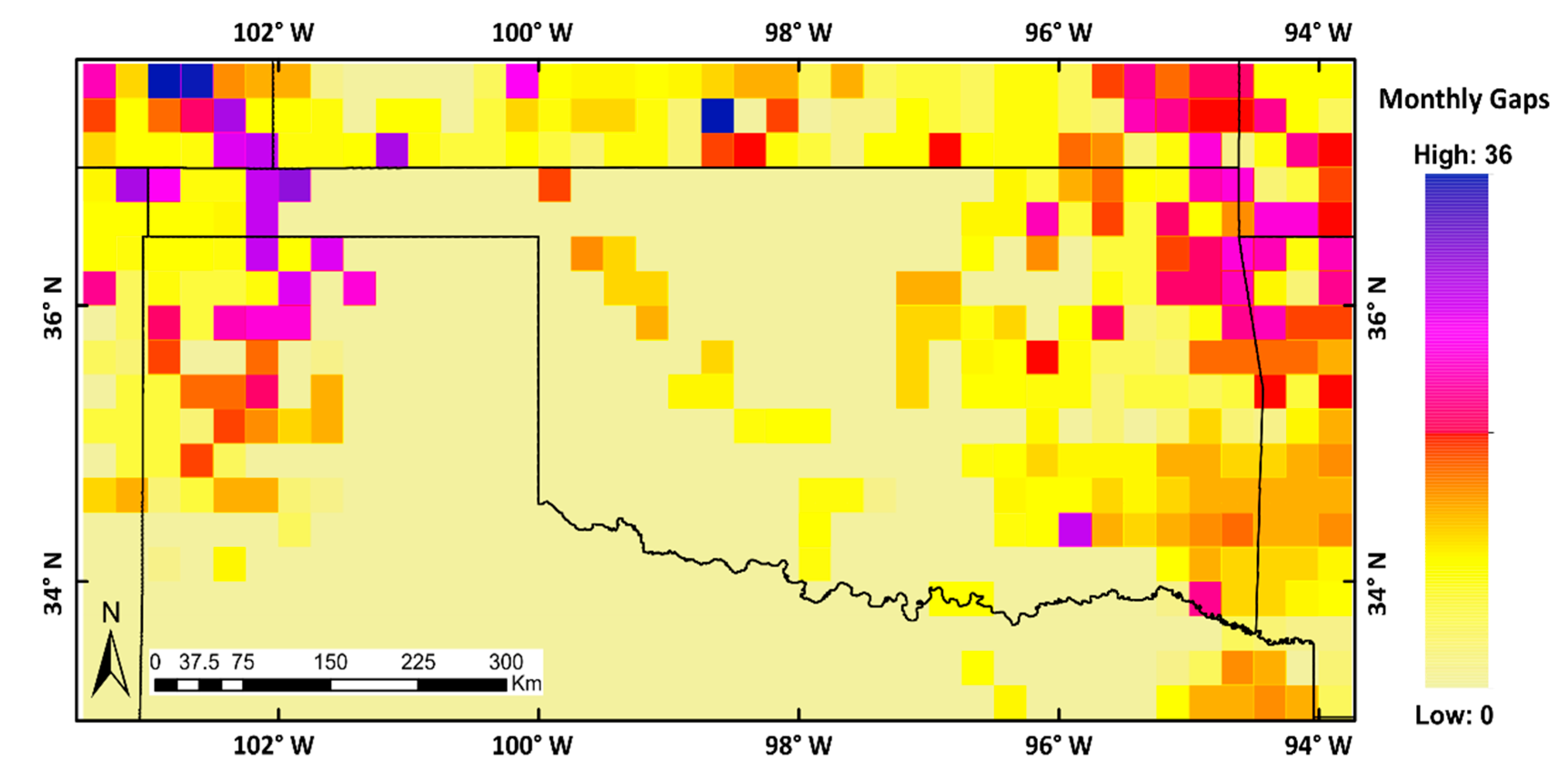
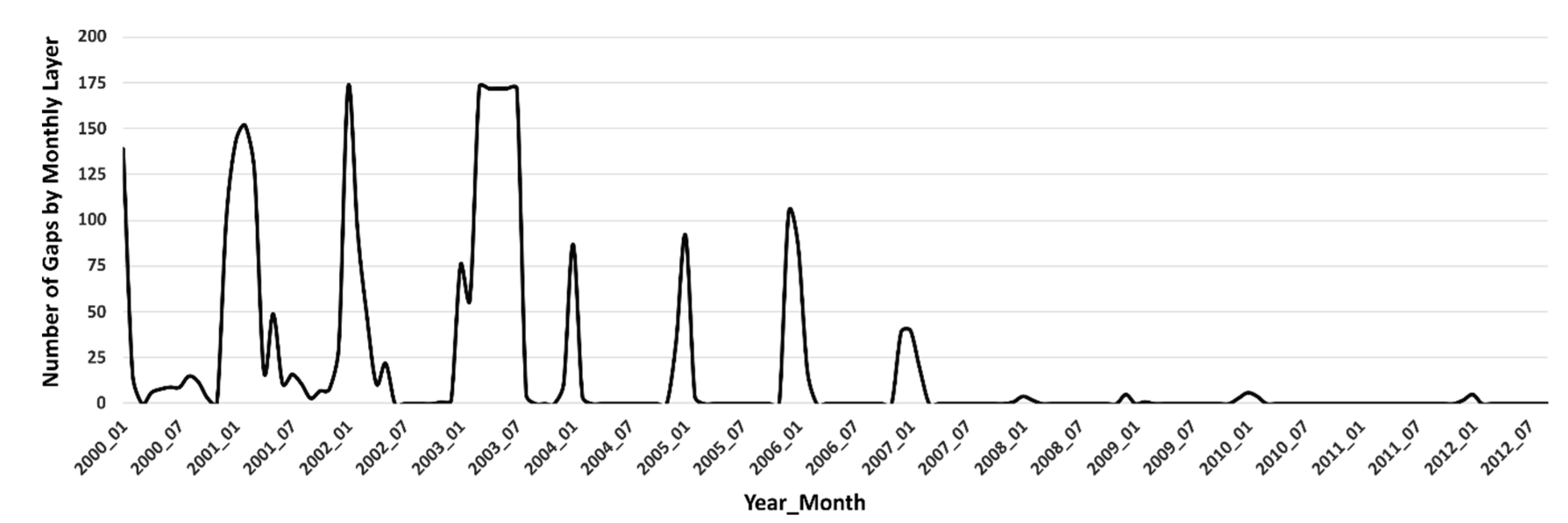
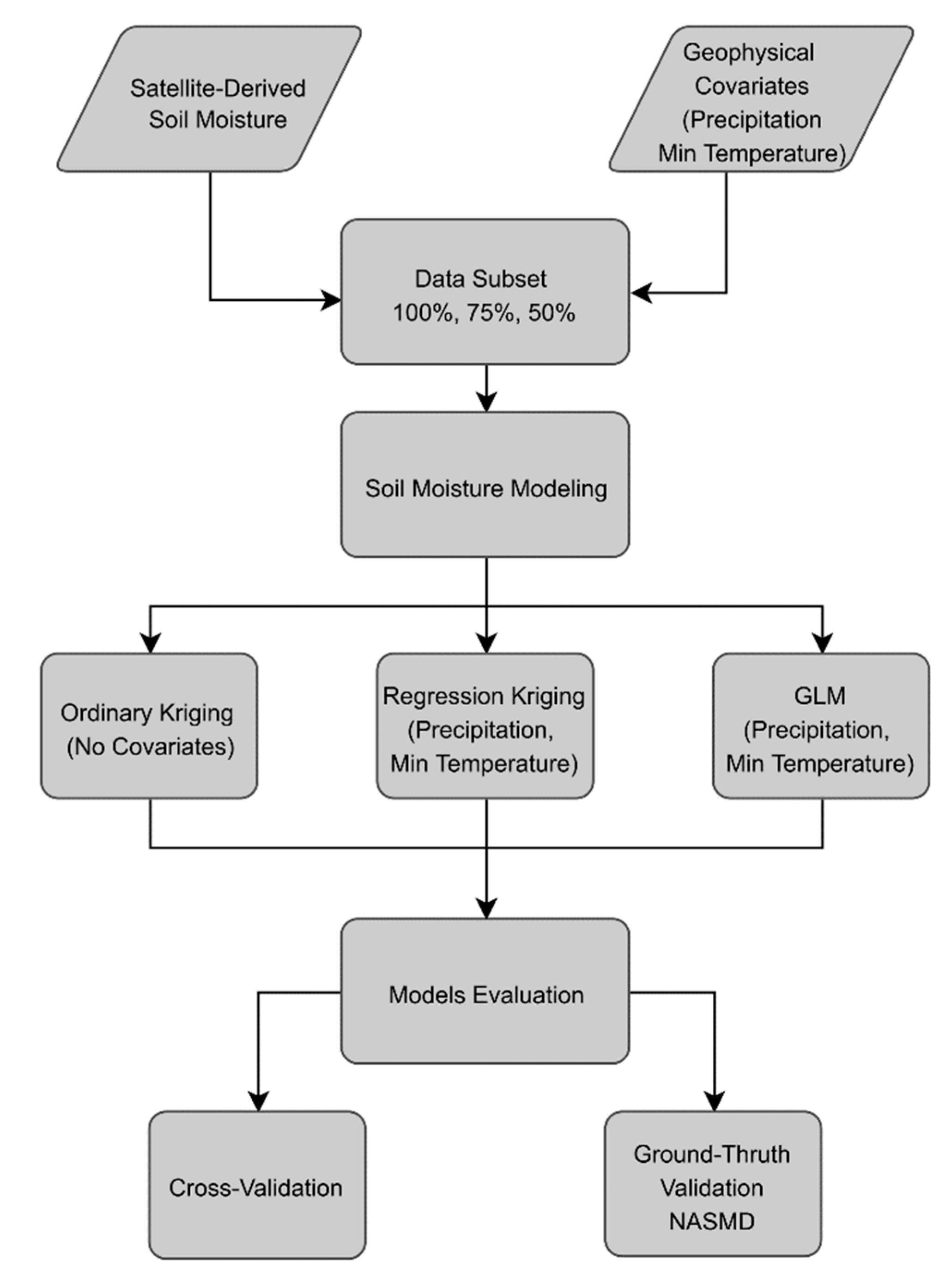
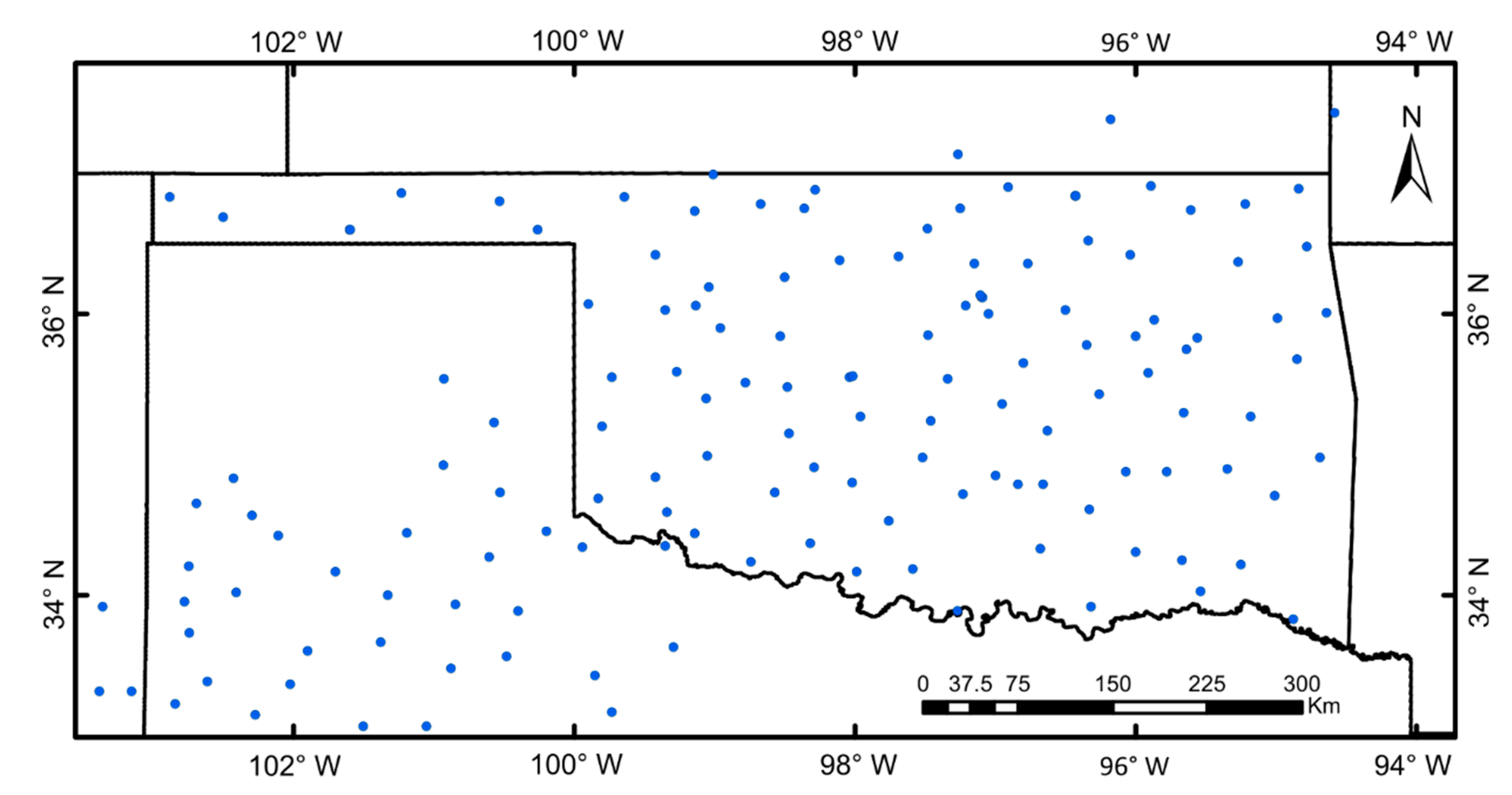
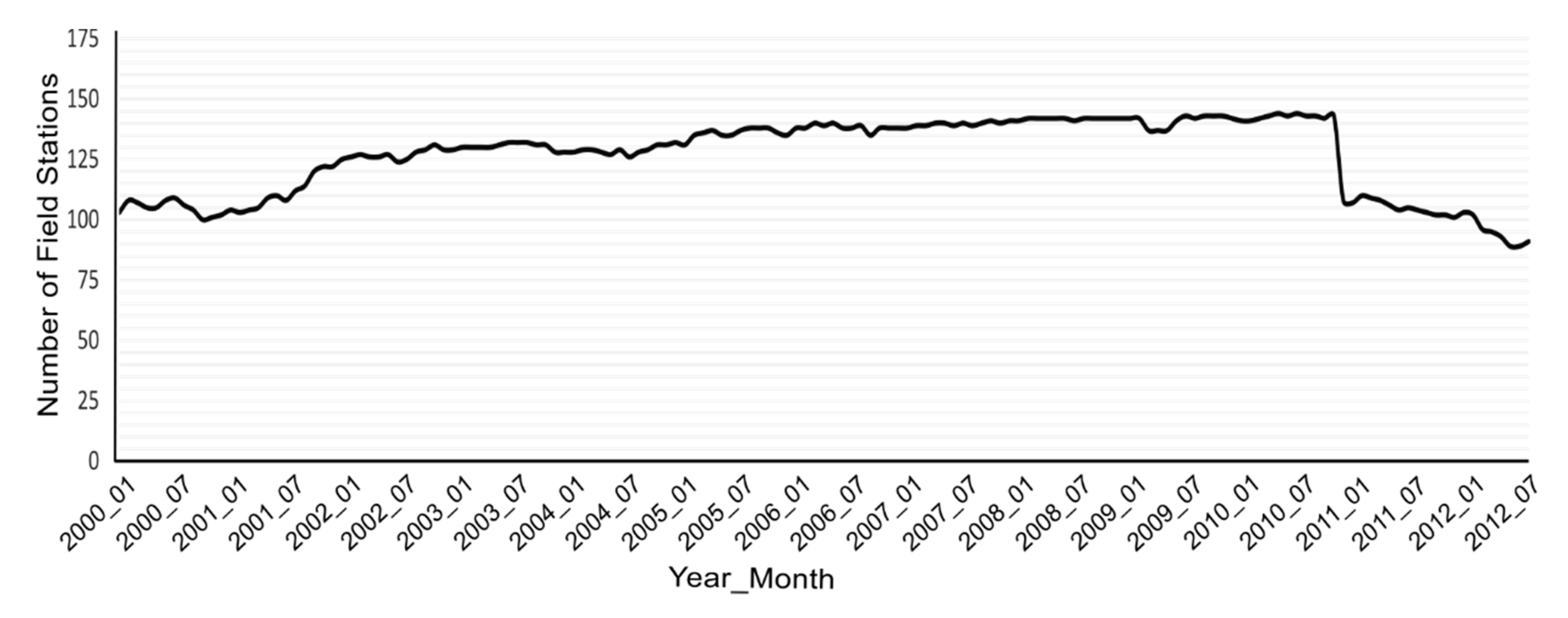

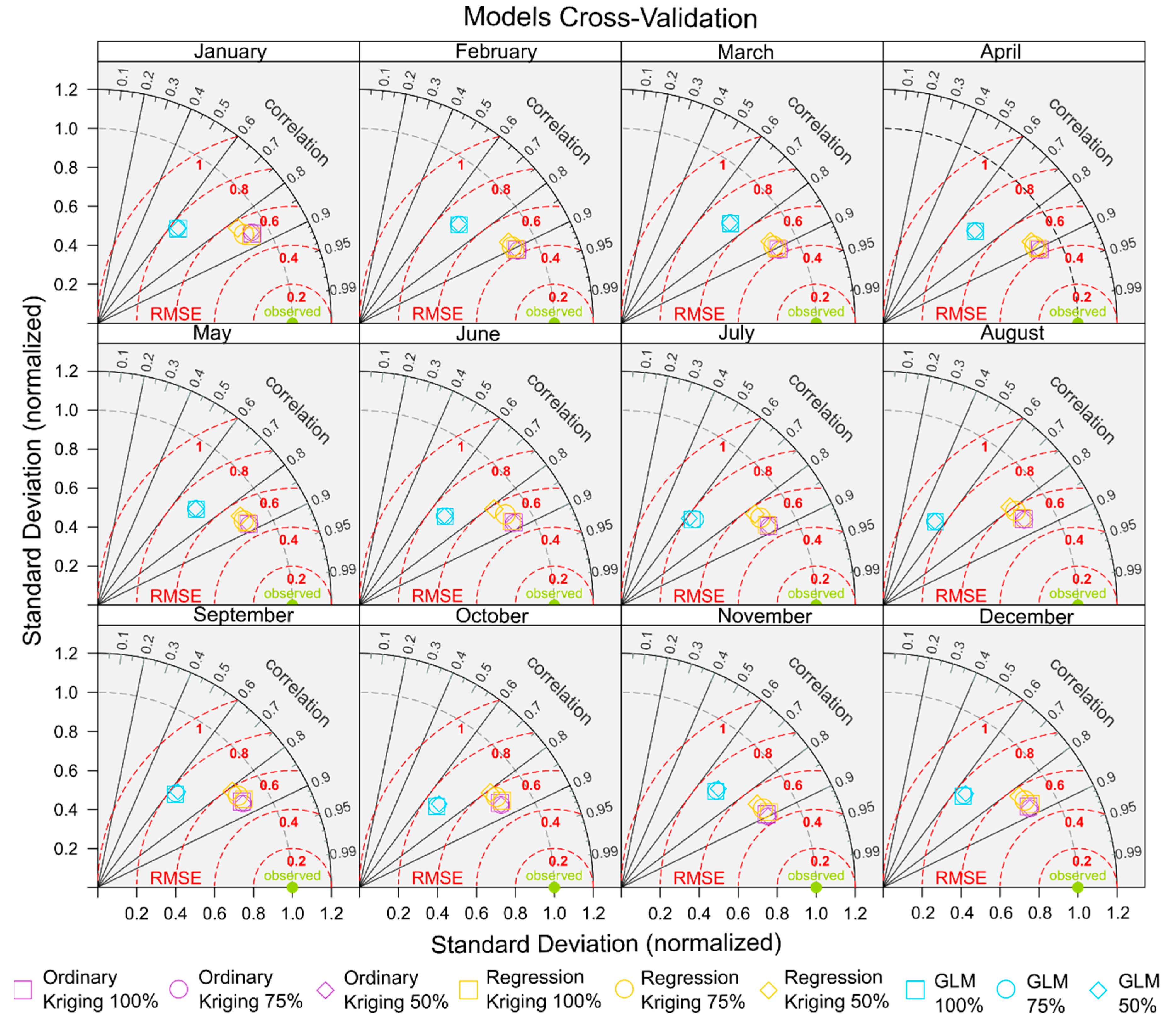
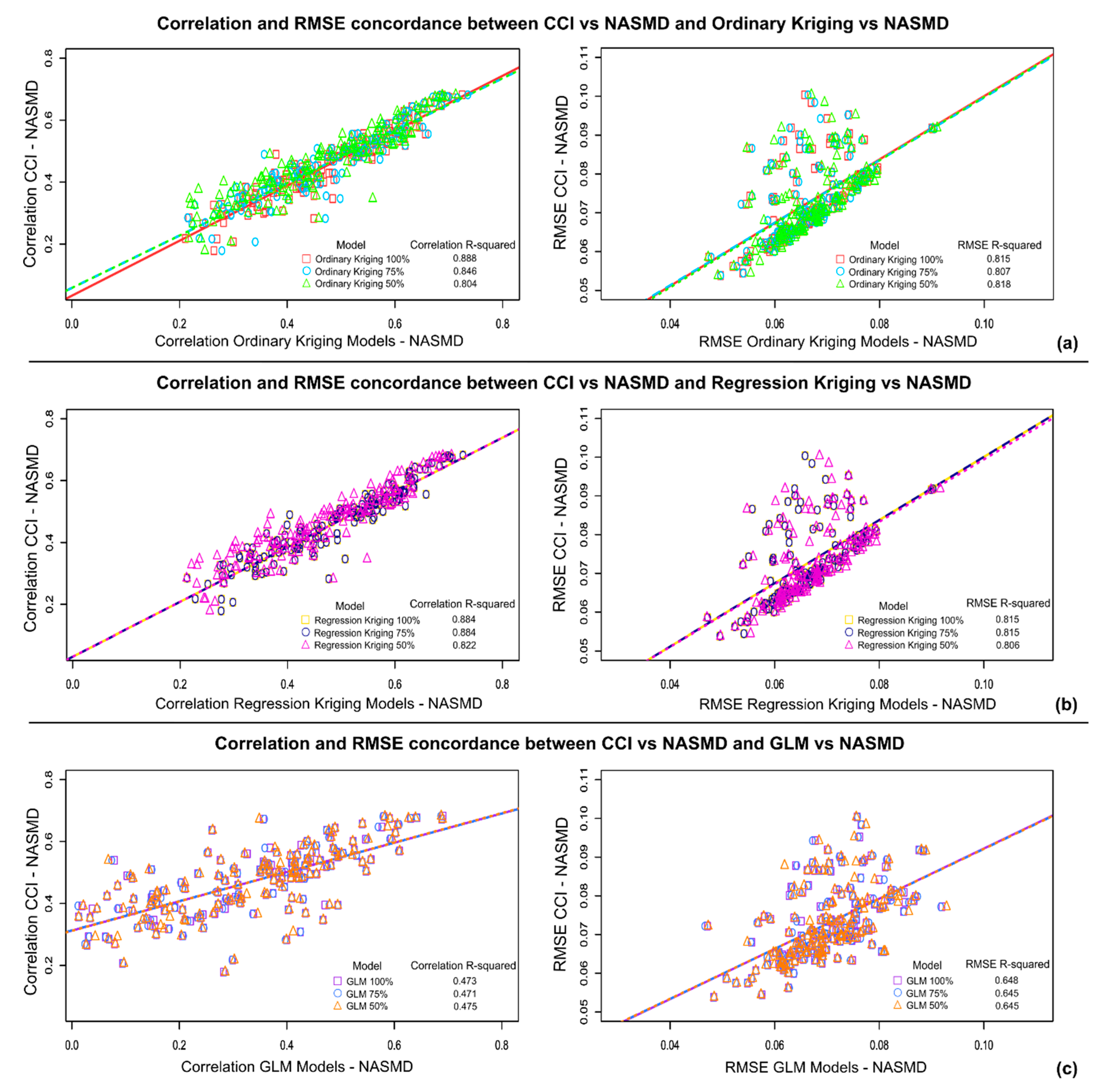


| Title ESA CCI Soil Moisture Version 4.5 | |
|---|---|
| Release date | October 2019 |
| Available products | Active |
| Passive | |
| Combined | |
| Scatterometer sensors used | SMMR SSM/I TMI AMI WS |
| ASCAT | |
| Radiometer sensors used | Windsat |
| AMSR-E | |
| AMSR2 | |
| SMOS | |
| Available time span | November 1978 to December 2018 (Combined product) |
| August 1991 to December 2018 (Active product) | |
| Method | Percentage of Data | Correlation | RMSE |
|---|---|---|---|
| OK | 100% | 0.886 | 0.029 m3m−3 |
| 75% | 0.886 | 0.029 m3m−3 | |
| 50% | 0.886 | 0.029 m3m−3 | |
| RK | 100% | 0.886 | 0.029 m3m−3 |
| 75% | 0.878 | 0.030 m3m−3 | |
| 50% | 0.869 | 0.031 m3m−3 | |
| GLM | 100% | 0.711 | 0.044 m3m−3 |
| 75% | 0.709 | 0.044 m3m−3 | |
| 50% | 0.709 | 0.044 m3m−3 |
| Method | Percentage of Data | Correlation | RMSE |
|---|---|---|---|
| CCI | 100% | 0.558 | 0.069 m3m−3 |
| OK | 100% | 0.579 | 0.067 m3m−3 |
| 75% | 0.575 | 0.067 m3m−3 | |
| 50% | 0.569 | 0.067 m3m−3 | |
| RK | 100% | 0.582 | 0.067 m3m−3 |
| 75% | 0.582 | 0.067 m3m−3 | |
| 50% | 0.571 | 0.067 m3m−3 | |
| GLM | 100% | 0.475 | 0.070 m3m−3 |
| 75% | 0.475 | 0.070 m3m−3 | |
| 50% | 0.475 | 0.070 m3m−3 |
© 2020 by the authors. Licensee MDPI, Basel, Switzerland. This article is an open access article distributed under the terms and conditions of the Creative Commons Attribution (CC BY) license (http://creativecommons.org/licenses/by/4.0/).
Share and Cite
Llamas, R.M.; Guevara, M.; Rorabaugh, D.; Taufer, M.; Vargas, R. Spatial Gap-Filling of ESA CCI Satellite-Derived Soil Moisture Based on Geostatistical Techniques and Multiple Regression. Remote Sens. 2020, 12, 665. https://doi.org/10.3390/rs12040665
Llamas RM, Guevara M, Rorabaugh D, Taufer M, Vargas R. Spatial Gap-Filling of ESA CCI Satellite-Derived Soil Moisture Based on Geostatistical Techniques and Multiple Regression. Remote Sensing. 2020; 12(4):665. https://doi.org/10.3390/rs12040665
Chicago/Turabian StyleLlamas, Ricardo M., Mario Guevara, Danny Rorabaugh, Michela Taufer, and Rodrigo Vargas. 2020. "Spatial Gap-Filling of ESA CCI Satellite-Derived Soil Moisture Based on Geostatistical Techniques and Multiple Regression" Remote Sensing 12, no. 4: 665. https://doi.org/10.3390/rs12040665
APA StyleLlamas, R. M., Guevara, M., Rorabaugh, D., Taufer, M., & Vargas, R. (2020). Spatial Gap-Filling of ESA CCI Satellite-Derived Soil Moisture Based on Geostatistical Techniques and Multiple Regression. Remote Sensing, 12(4), 665. https://doi.org/10.3390/rs12040665





